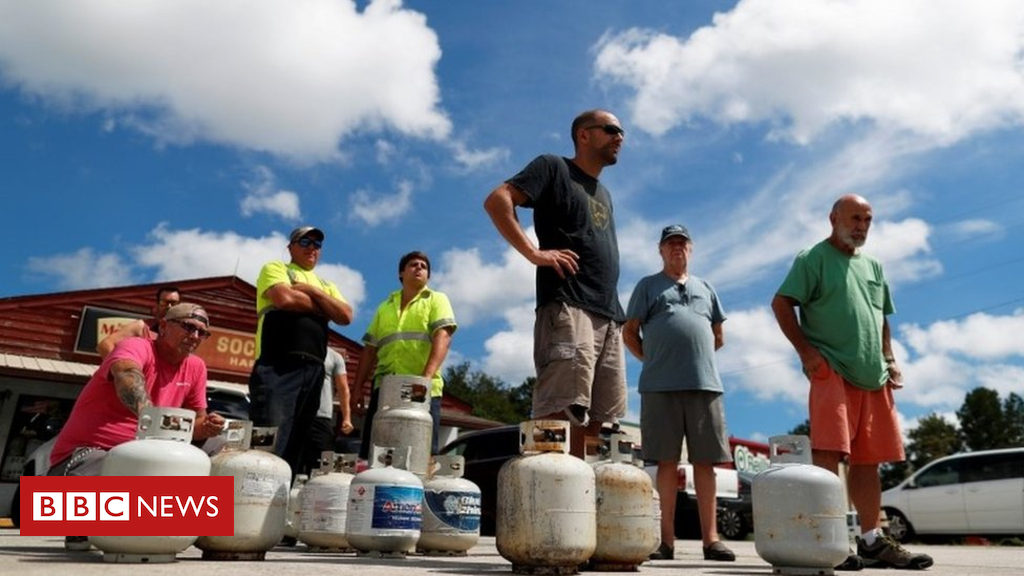Hurricane Florence – the most powerful storm to threaten the Carolinas in nearly three decades – is expected to strengthen, say forecasters.
Officials warn there is a chance of “life-threatening inundation from rising water” over the next 48 hours as Florence heads for the US East Coast.
With sustained winds of about 130mph (215km/h), the weather system is currently a category four storm.
It could make landfall on Thursday, near Wilmington, North Carolina.
Virginia, Maryland, Washington DC, and North and South Carolina have all declared states of emergency.
“This storm is a monster,” North Carolina Governor Roy Cooper told a news conference on Tuesday. “It’s big and it’s vicious.
“It is an extremely dangerous, life-threatening, historic hurricane.”
Image copyright AFP
The latest National Weather Service (NWS) update on Tuesday morning says Florence is expected to “continue a slow strengthening trend for the next day or so”.
It could weaken on Thursday, according to current predictions, but officials cautioned Florence will most probably remain “an extremely dangerous major hurricane through landfall”.
The NWS predicts potential storm surges of up to 12ft (3.6m) on the coasts along with dangerously large swells and rip currents.
Image copyright Reuters
US President Donald Trump signed declarations of emergency on Tuesday for both North Carolina and South Carolina, freeing up federal money and resources for storm response.
He tweeted that this was “one of the worst storms to hit the East Coast in many years”.
Mandatory evacuations have been ordered in parts of South Carolina, North Carolina and Virginia, affecting more than a million people.
South Carolina’s Governor Henry McMaster gave the entire coastline of his state until noon on Tuesday to leave.
The Brunswick Nuclear Plant in Southport, North Carolina, is just a few miles from where Florence is expected to make landfall.
Image copyright Reuters
The chief meteorologist for WCBD-TV in South Carolina, Rob Fowler, told the BBC that Florence was getting bigger, and those even 100 miles away would feel the impact.
He said Florence could rival the impact of Hurricane Hugo, which wreaked $7bn (£5.3bn) in damage and claimed 49 lives in 1989.
The office of Virginia Governor Ralph Northam predicted “catastrophic inland flooding, high winds and possible widespread power outages”.
Rainfall could be up to 20in (50cm) in some areas. This could worsen if, as some meteorologists predict, Florence stalls after it makes landfall.
The US Navy is sending 30 ships stationed in Virginia out to sea.
Residents of affected areas have been flocking to stores to stock up on essentials.
John Johnson, a hardware store manager in Charleston, South Carolina, told AFP news agency there had been a “nonstop” rush on batteries, flashlights, plastic tarpaulins and sandbags.
Image copyright Reuters
Some petrol stations were running dry as customers filled up.
Curtis Oil, a fuel distributor in Chesterfield, South Carolina, said it had been “overwhelmed with requests by state agencies and everybody else”.
Lack of flood insurance
The US government has a National Flood Insurance Programme (NFIP) that helps pay for flood coverage in high-risk zones across the country.
The programme, which is billions of dollars in debt, has been up for renewal several times – Congress’ next deadline to reauthorise the NFIP is 30 November of this year.
Image copyright EPA
While some wind damage may be covered by regular homeowners’ insurance, flooding is a different story.
In the US, flood protection policies from private providers are often very expensive, largely because it is difficult to assess a home’s flood risk.
These policies also take 30 days to kick in, meaning any homeowners without coverage in the Carolinas now will not be able to insure their property before Florence hits.
According to the Insurance Information Institute, 14% of Americans living in the southern states had flood insurance as of 2016.
Hawaii storm
On the opposite side of the country, officials in Hawaii are warning residents and tourists to brace for the arrival of Tropical Storm Olivia.
Forecasters say Olivia – with current wind speeds of 65 mph – will make landfall on Wednesday morning.
Schools and state parks have closed. Ten to 15in (25 to 38 cm) of rain is forecast for the Big Island.
Are you in the area? How are you preparing for the hurricanes? Let us know by emailing haveyoursay@bbc.co.uk.
Please include a contact number if you are willing to speak to a BBC journalist. You can also contact us in the following ways:
- WhatsApp: +447555 173285
- Tweet: @BBC_HaveYourSay
- Send pictures/video to yourpics@bbc.co.uk
- Upload your pictures/video here
- Send an SMS or MMS to 61124 or +44 7624 800 100
- Please read our terms and conditions and privacy policy
Or use the form below








